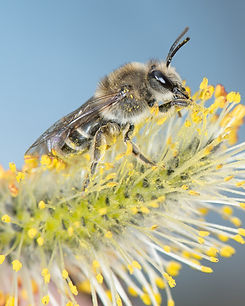
Family Halictidae > Genus Augochlora
Augochlora pura
Pure Green Metallic Sweat Bee
In Minnesota, there is one described species within the genus Augochlora — Augochlora pura. Of the four metallic green sweat bee genera, all nest in the ground except for Augochlora pura. This bee has solitary nests in dry-rotting cavities in wood such as in a log lying on the ground, dead tree limb, or stump. Augochlora pura produces two generations per year (bivoltine) in Minnesota.
This species has a metallic green head, thorax, and abdomen; is small to medium-sized; and ranges in length from 5 to 9 mm (0.3 to 0.37 inches). Other characteristics include black mandibles with two similarly sized teeth, dark brown wings, a well developed paraocular lobe, sharp inner margins on the compound eyes, and a uniformly smooth scutum. Also, females have a central keel on the first sternite (S1).

An Augochlora pura female visiting Symphyotrichum (aster).

An Augochlora pura female guards her nest cavity in a rotting log.

An Augochlora pura female visiting Geranium maculatum.

An Augochlora pura female visiting Solidago rigida.

Parthenocissus inserta
(woodbine)
wing
position
on flowers

N0. species in MN
1
size range

Phenology

Genus/Species
Characteristics

Females with black mandibles and two similarly-sized apical teeth.

Females with broad gena (cheek), dark wings, and black femora and tibiae.

Males and females with broad vertex (space between simple eyes and back of head), wings dark.

Female with acute right angle indentation on inner margin of compound eye (1) and well developed paraocular lobe (2).
1
2

Male with slender form, dark wings, green femora, front and mid trochanters black, hind trochanter green.

Male with long antennae, dark eyes, and dark brown wings.
Distribution

Minnesota

Regional Map
Augochlora pura (Say, 1837) in GBIF Secretariat (2023). GBIF Backbone Taxonomy. Checklist dataset https://doi.org/10.15468/39omei accessed via GBIF.org on 2024-12-20.

Habitat
Augochlora pura nests in cavities in wood, often in dry-rotting wood in a dead tree limb, stump, or log lying on the ground.

Females initiate nests using pre-existing cavities in wood. They further excavate the soft wood fibers to form chambers that contain clusters of brood cells.
Behavior
Life Cycle
Two Generations Per Year, Reproductive Female Overwinters as Adult

Augochlora pura produces two generations per year (bivoltine) and reproductive females overwinter as adults.
Plant
Associations

Symphyotrichum spp.
(asters)

Rudbeckia hirta
(black-eyed Susan)

Erigeron spp.
(fleabane)

Geranium maculatum
(wild geranium)

Helenium autumnale
(sneezeweed)

Asclepias tuberosa
(butterfly milkweed)

Solidago spp.
(goldenrod)

Campanula americana
(American bellflower)

Veronicastrum virginicum
(Culver's root)

Agastache foeniculum
(anise hyssop)

Ageratina altissima
(white snakeroot)

Zizia americana
(golden Alexanders)

Prunus virginiana
(wild plum)

Osmorhiza spp.
(aniseroot)
Photo Galllery




Explore More Halictidae Genera
Explore Bee Families

Apidae
15 genera, 133 species
Bumble bees Bombus
Longhorn bees
Epimelissodes, Eucera, Melissodes
Carpenter bees
Ceratina, Xylocopa
Honey bees Apis
Digger bees Anthophora
Cuckoo bees Brachymelecta, Epeolus, Holcopasites, Nomada, Neolarra, Triepeolus
Squash bees Xenoglossa

2 genera, 39 species
Halictidae
10 genera, 133 species
Metallic green sweat bees
Agapostemon, Augochlora, Augochlorella, Augochloropsis
Large sweat bees
Dieunomia, Nomia
Short-faced bees Dufourea
Sweat bees Halictus
Small sweat bees Lasioglossum
Cuckoo (blood) bees Sphecodes
Megachilidae
14 genera, 86 species
Resin and pebble bees Anthidiellum, Dianthidium, Heriades, Paranthidium
Carder bees Anthidium, Pseudoanthidium
Mock orange bees Chelostoma
Mason bees Osmia, Hoplitis
Leafcutter bees Megachile
Sharp-tailed cuckoo bees Coelioxys
Dark cuckoo bees Stelis

Citations and Further Reading
Droege, S., et al. (2024). The Very Handy Bee Manual: 2.0. How to Catch and Identify Bees and Manage a Collection.
Gibbs, J., Hanuschuk, E., Miller, R., Dubois, M., Martini, M., Robinson, S., ... & Onuferko, T. M. (2023). A checklist of the bees (Hymenoptera: Apoidea) of Manitoba, Canada. The Canadian Entomologist, 155, e3.
Mitchell, T. B. (1960). Bees of the eastern United States. Technical Bulletin No. 141. North Carolina Agricultural Experiment Station.
Portman, Z. M., Gardner, J., Lane, I. G., Gerjets, N., Petersen, J. D., Ascher, J. S., ... & Cariveau, D. P. (2023). A checklist of the bees (Hymenoptera: Apoidea) of Minnesota. Zootaxa, 5304(1), 1-95.
Portman, Z. M., Arduser, M., Lane, I. G., & Cariveau, D. P. (2022). A review of the Augochloropsis (Hymenoptera, Halictidae) and keys to the shiny green Halictinae of the midwestern United States. ZooKeys, 1130, 103.
Wilson, J. S., & Messinger Carril, O. J. (2016). The bees in your backyard: a guide to North America's bees. Princeton University Press.

















